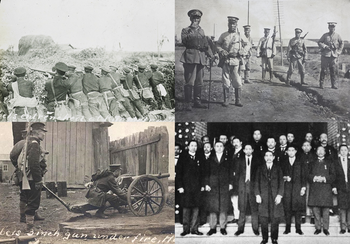Chinese Civil War (China's Song)
| Chinese Civil War | |||||||
|---|---|---|---|---|---|---|---|
 Clockwise from top left: Nationalist forces entrenched at the Battle of Jinan, Beiyang troops photographed in 1914 outside of Beijing, Sun Yat-sen shortly after establishing the new government in Nanjing, Nationalist artillery company in combat at the Siege of Beijing | |||||||
| |||||||
| Belligerents | |||||||
|
|
Supported by: | ||||||
| Commanders and leaders | |||||||
|
|
| ||||||
| Strength | |||||||
| 150,000 | 135,000 | ||||||
The Chinese Civil War, also referred to as the Second Revolution, was an armed conflict lasting from 1914 to 1919 between the southern-based Nationalists and the northern-based Beiyang government.
The roots of the civil war were planted after President Yuan Shikai stormed the National Assembly in August 1913 and dissolved the Song Jiaoren's government. Less than three days later, President Yuan was shot three times by gunman Huang Fu. Li Yuanhong, Yuan's Vice President, assumed the presidency and announced new elections would be called for both the National Assembly and the presidency. President Li's pro-democracy stance angered the Beiyang Army, leading to General Duan Qirui seizing power in September. China's southern provinces decried Duan's coup and former President Sun Yat-sen began to raise armies in case of a war against Beijing. Divisions in the Beiyang Army became apparent as Duan embraced cronyism and alienated his potential rivals. These generals, namely Feng Guozhang and Cai E, broke their ties with Beijing in January and negotiated an alliance with Sun Yat-sen. As Duan realized his power was getting contested, he declared martial law in February and ordered his army to secure all of China.
Sun Yat-sen, similarly to the first revolution, declared a new government in Nanjing with the backing of all of southern China.